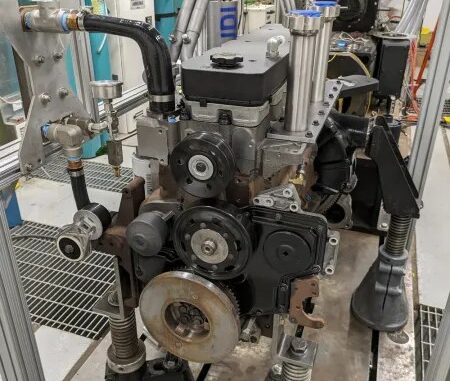
A Minnesota company is among a growing number of startups nationwide hoping to help customers replace diesel and natural gas with ammonia in industrial applications.
“It’s not as big of a leap as you might think to retool and change an engine from running diesel to ammonia,” said Aza Power co-founder and CEO Seamus Kane. The company is developing conversion kits that allow diesel engine owners to switch their energy source to ammonia and reduce their carbon emissions.
Ammonia is a pairing of hydrogen and nitrogen, which means it doesn’t emit carbon when burned. Its production is typically very carbon intensive, however, accounting for about 2% of the world’s total carbon emissions, according to the International Energy Agency.
More than 70% of ammonia produced today ends up as liquified gas in nitrogen fertilizer that farmers inject into soil. Other major uses for ammonia include as a refrigerant and cleaning solution. The chemical has a long history as an experimental transportation fuel, having been a base for a NASA and Air Force jet, the X-15, that set a speed record in the 1960s that has not been matched.
Today, startups are also testing ammonia as a combustion fuel and as a medium for transporting hydrogen, another potential clean energy source in which the federal government is investing billions of dollars.
In the last few years, several countries have begun producing “green” ammonia using renewable electricity. China, India and Australia are building green ammonia plants to mainly serve hydrogen fuel cell vehicles.
Aza Power is a spinoff of research at the University of Minnesota Morris, where a facility uses wind power to produce green ammonia and hydrogen. Will Northrop, director of the University of Minnesota’s Thomas E. Murphy Engine Laboratory in Minneapolis, has been studying and testing the idea of replacing diesel with ammonia in tractors and other engines since 2016. A few years ago he received $12.5 million from the Legislature to study ammonia as an energy carrier.
The company sells conversion hardware allowing clients to switch from fossil fuels to ammonia and offers a maintenance agreement to provide any required service after installation. Kane, the co-founder, said that any machine with a piston engine is a prospect for conversion.
The company’s core technology replaces diesel fuel injector components in common diesel engines used in trucks, earthmovers, tractors, generators and other products.
“We would be able to package the technology so that it can go for a bunch of different engines,” he said.
The company recently received support and funding from the clean energy incubator Grid Catalyst and from Minnesota Energy Alley, a new program managed by Clean Energy Economy Minnesota.
Ammonia has potential advantages as a clean fuel. One is that it’s already one of the most commonly produced chemicals in the world. A global distribution network exists for producing, storing and transporting about 175 million tons annually.
In addition to use as a combustion fuel in certain engines, ammonia could serve as a safe and efficient way to transport hydrogen. Its production can be reversed, splitting off the hydrogen in a process known as “cracking.” Ammonia’s ability to store energy is eight to 12 times higher than the best performing lithium-ion batteries based on measures such as kilowatt hours per kilogram, Kane said.
“Ammonia is just a liquid in a tank,” he said, requiring no wires or cases that batteries require.
Tim Krebs, Aza Power’s chief financial officer, serves on the boards of other ammonia startups and comes from an oil and gas background. After lithium-ion and hydrogen, ammonia will become “the next complement for decarbonizing the world and as a way to move hydrogen around the planet,” Krebs said.
He lists off the potential market: Offroad tractors, mining equipment, bulldozers, locomotives, mining equipment, tractors, backhoes and maritime fleets, especially ferries and tugboats. These kinds of engines can be converted to burn ammonia without great expense, he said.
A variety of market reports are available on the growth of green ammonia and green transportation. ChemAnalyst, which studies industries involved in chemical commodities, suggests in a report that ammonia fuel demand will grow more than 14% annually for use in transportation, power generation and industrial feedstock.
Mike Reese, renewable energy director at the outreach center, believes ammonia could be one of the solutions for fueling machinery and storing energy. Ammonia “is well understood and financeable” compared to other competing technologies such as fuel cells, he said.
Reese said the cost of ammonia needs to decline to be competitive, but it may still cost less than lithium-ion battery technologies.
“Batteries have proven to be very expensive at scale and less is known about the performance,” he said. “I think it’s reasonable to move towards power generation using ammonia in internal combustion engines.”
The size of the entire market remains hard to gauge but Kane provides a glimpse of the generator marketplace. In working with Grid Catalyst, Aza Power has been developing technology to replace diesel in electric generators. That market alone is a “$35 billion to $40 billion globally,” Kane said.
Kane said Aza Power and other startups still need green ammonia from renewable energy to grow significantly from its tiny market share. Even green ammonia, though, creates some emissions. When burned to produce energy, green ammonia can emit nitrogen oxides (NOX) and nitrous oxides (N2O), which have a “global warming potential” 300 times greater than carbon emissions. Improved combustion technologies could help reduce emissions dramatically, he said.
Kane said Aza Power meets NOX emissions set by the EPA for by using mature catalytic formulations. The N20 emissions occur in any fuel combustion but Aza Power’s conversion technology reduced greenhouse gas emissions, including N20, by 80% to 90% over diesel engines, he said. He’s “confident” the number will rise to 98% next year.
Trevor Brown, executive director of the 262-member Ammonia Energy Association, said Aza Power is exploring a potentially lucrative market of industries that will need to decarbonize vehicles and engines. Achieving net-zero emissions will require a portfolio of technologies and ammonia’s global reach and transportability make it a potential solution, he argued. The industry needs policy support to compete with fossil fuels, though.
“There’s no cheaper solution than fossil fuels,” Brown conceded.
Aza Power’s main U.S. competitor is Amogy, a startup with nearly $200 million in venture capital primarily from Amazon’s Climate Pledge Fund. Amogy combines ammonia with fuel cell technology for decarbonizing the transportation sector and has developed an ammonia-powered tractor.
After the Grid Catalyst engagement ends, Aza Power wants to raise seed capital for an 18 month development time to scale their generation technology to bigger engines. It is eyeing other markets, namely locomotives running on diesel, and has a partner with expertise in converting trains to run on alternative fuels.
Kane also sees the mining industry, an important player in Minnesota, as another market.
“Those applications in mining that use big engines where we’re looking at scaling up our conversion technologies,” he said.



